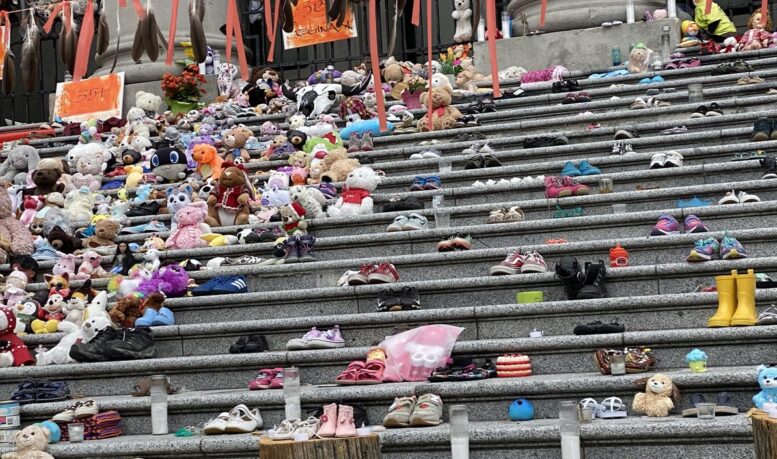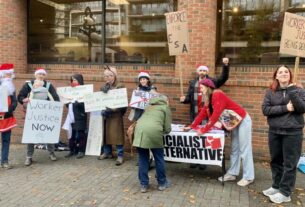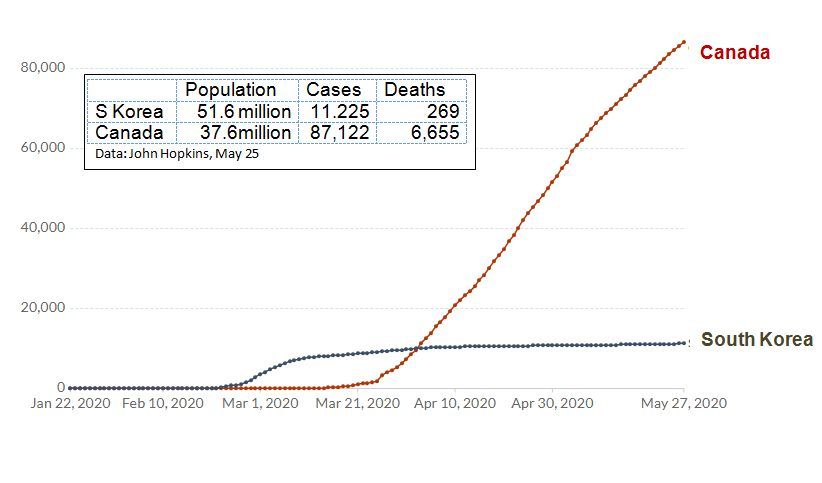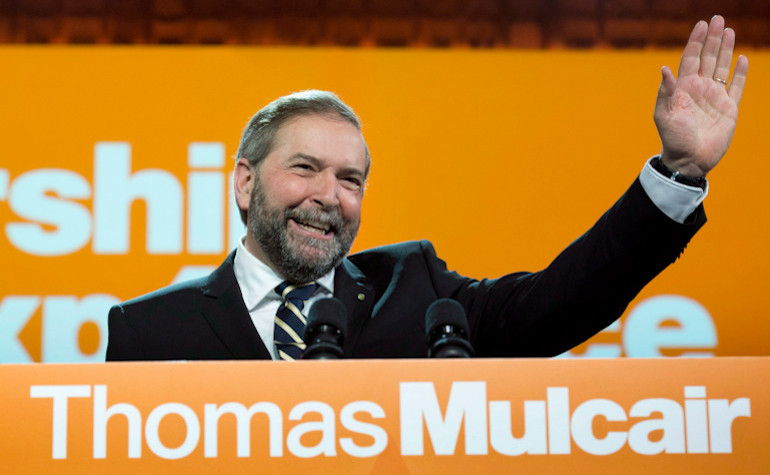Allie Pev, Métis Cree, Treaty 6, is a member of Socialist Alternative Canada.
Canada is stolen land. Canada continues to steal Indigenous lives.
One of the most gruesome of Canada’s crimes against Indigenous peoples has been the theft of Indigenous children. Over 1,000 unmarked graves on residential school grounds have been recovered so far; this number will grow until all 139 schools are searched. There is no way to quantify how much has been stolen; children were taken, many who would be Elders by now with generations below them, raising children of their own. The news is extremely re-traumatizing and continues to develop on top of a global pandemic, which has disproportionately affected those in poverty, women and Black, Indigenous and people of colour.
The growing climate crisis, deadly heat wave, opioid crisis, and constant land struggles add to the issues Indigenous peoples experience. The systems that uphold the Canadian state are systems that abuse, exploit and kill Indigenous peoples. These capitalist horrors are not solely in the past nor are they new, but rather ongoing injustices perpetrated to maintain control, ownership and ability to profit from the land.
July 1 marked 154 years of confederation and the Canadian state’s occupation of Indigenous homelands. To be clear, Indigenous peoples have never stopped resisting the violence of Canada and have never surrendered. There is a long history of Indigenous resistance including the Constitution Express in 1969 in response to Pierre Trudeau’s and Indian Affairs Minister Jean Chrétien’s White Paper, which proposed to abolish the Indian Act and all existing treaties within Canada and to assimilate First Nations as an ethnic group equal to other Canadian citizens. Idle No More was born in resistance to the Harper government’s dismantling of environmental protection laws. These acts of resistance led the way for Cancel Canada Day this year.
Internationally, land defenders have been protecting Mauna Kea in Hawaii and Standing Rock was the site of fierce opposition to the Dakota Access Pipeline. Wet’suwet’en hereditary leaders, Six Nations at 1492 Land Back Lane, Mi’kmaq community members, and land defenders at Fairy Creek have been and will continue to defend their territories against ruinous industry expansion and the police state that protects it.
Our determination to uphold our responsibilities to our lands, languages, culture, way of life and future generations has never disappeared. Those responsibilities have been carried out underneath a blanket of colonialism for hundreds of years. The history of Canada reflects the intersections among colonialism, imperialism, capitalism, racism, police violence and environmental destruction. All facets of contemporary Canadian society have a historical basis that is still impacting all present-day institutions, policies, consciousness and day-to-day life.
Force as a Tool of State Oppression
Prior to contact Indigenous peoples lived in complex and vibrant societies, respecting the land as the sustainer of life, understanding the interrelatedness with the land, the water and all creatures. This relationship extends beyond any versions of ownership and possession. Colonialism, imperialism and capitalism flat out reject any type of relationship with the land that isn’t motivated by commodification, exploitation and profit. Capitalist expansion demands unending growth and requires ever-expanding markets. Canada’s land mass was considered “unused” and ready for the taking. By the time of Canada’s Confederation in 1867, the industrial revolution had spread and fully taken hold in Europe and the US under a capitalist mode of production. The first Canadian government under John A. Macdonald sought to aid in this expansion, opening the west to business and settlers to facilitate profit making.
This cannot be done by sheer government direction alone. It needs force to implement and maintain its will. The North-West Mounted Police (now the RCMP) formed in 1873 to maintain law and order in the Northwest Territories and squash any resistance to Canadian expansion. In 1869, two years after Canada’s Confederation, the new government of Canada passed resolutions calling for the transfer of the Hudson’s Bay Company territory (Rupert’s Land) to Canada. Even before the final agreement was completed, the Canadian government had sent roadbuilding crews and surveying teams into Red River, the territory of the Métis. The Métis were not consulted – the government was moving ahead with the transfer of land as if no one lived in that area.
Louis Riel led the resistance and organized the territory of Assiniboia, leading to the creation of the province of Manitoba. Later in 1884-85, Riel and Gabriel Dumont led the Provisional Government of Saskatchewan against the Dominion of Canada in an attempt to assert Métis claims to sovereignty, land title, and political rights. By 1885 the Canadian government amassed almost 3,000 troops to be transported west across even unfinished gaps in the new Canadian Pacific Railway. In the end, on May 12, 1885, the Métis were defeated at Batoche. Riel was convicted of treason and sentenced to be hanged. He died on November 16, 1885. This is just one example of the force used by the Canadian state to repress Indigenous peoples. The North-West Mounted Police was created to crush Métis resistance and clear the plains. Buffalo, a primary food source, were deliberately killed almost to extinction to starve plains nations and easily relocate them to isolated reserves, facilitating a quick transition to settlement, farming and business.
Another tactic to open the land for settlement was to sign treaties. As Chelsea Vowel writes in Indigenous Writes, Indigenous peoples have a long history of treaty making with other nations such as the The Great Law of Peace, which united five nations into the Haudenosaunee. “[T]hese inter-Indigenous treaties were highly sophisticated oral agreements between sovereign peoples. They covered everything from trade agreements to the settlement of conflicts… and specific ways in which these treaties would be renewed.” First Nations’ understanding of the numbered treaties are that they were based on extensive oral negotiations and that never at any point did Treaty First Nations relinquish their right to nationhood, or their right to determine their own destinies. They meant for the treaties to evolve. “Relationships must be renewed with constant care, negotiation, and openness to change” (p. 244).
Canada had no intention of honouring the treaties past the moment they secured the land they needed, which is why the numbered treaties are filled with “surrender” clauses. An example from Treaty 6 states that “Indians inhabiting the district… described and defined, do hereby cede, release, surrender and yield up to the Government of the Dominion of Canada, for Her Majesty the Queen and Her successors forever, all their rights, titles and privileges… to the lands included within [these] limits.” The numbered treaties exist within the Canadian state’s colonial legal system, which exists for its own self-interest, to retain its claim to sovereignty. The treaties forced nations onto a mere fraction of their actual ancestral territories. The state had their NWMP but they also needed laws to control Indigenous peoples.
Legislated Genocide
The Canadian state required an all-encompassing set of policies and laws addressing nearly every aspect of Indigenous existence to control and eventually assimilate Indigenous peoples. The Indian Act is one of the most genocidal pieces of legislation ever to be implemented. For many years it prohibited bands from raising money or accessing lawyers to pursue land claims. It defined who was and who was not an “Indian” under Canadian law with absolutely no regard for complex kinship systems; many women and their descendants lost status this way. Hereditary and matriarchal leadership systems were undermined by the implementation of the Band and Council system. To further assault Indigenous identity, the Act banned the Potlatch and Sun Dance ceremonies and eventually came to oversee the expansion of residential schools, granting churches financial and political support.
Children were stolen from their families and communities, taken sometimes hundreds of miles away to attend these residential institutions. Also in operation were Indian Affairs’ day schools. In these places children experienced horrific treatment, subjected to mental, physical, psychological, sexual and spiritual abuse. Many children never made it home and their families never learned what had happened to them or knew their final resting place.
Everything I have described so far is the inescapable reality for Indigenous peoples.
Systemic Racism
Indigenous peoples were forcefully displaced to small portions of land, dispossessed of traditional territories and food systems, leaving them unable to retain self-sufficient and reciprocal relationships with the land. Indigenous kinship and governance systems have been disrupted, forcing communities to become dependent on the colonial system, leading to cycles of poverty. The Canadian state intentionally ignores poverty, inadequate housing, and on some reserves, no access to clean drinking water (basic human rights), leaving communities in deadly situations.
Indigenous peoples endure the disproportionate harm done by reactionary, punitive and racist systems. 52.2 percent of children in foster care are Indigenous, but account for only 7.7 percent of the child population. Indigenous adults account for more than 30 percent of those in federal custody but only 5 percent of the population. Indigenous women and girls are 12 times more likely to be murdered or missing than other women. Chantal Moore, an Indigenous woman from Tla-o-qui-aht First Nation, was shot and killed by a New Brunswick police officer during a wellness check. It was announced in June that the police officer won’t be facing criminal charges because, according to Crown, there was no reasonable prospect of a conviction based on the evidence.
In BC, First Nations people are disproportionately represented in overdose deaths, dying at 5.6 times the rate of other BC residents. Inuit suicide rates are among the highest in the world and like Black communities, Indigenous peoples are more likely to be racially profiled and be the victims of police violence. In July, Jared Lowndes, a Wet’suwet’en man who was a father of two, was boxed in his car by RCMP. The police released their dog on him before shooting and killing him. Only a week prior to his murder by police, Lowndes wrote an account of his life detailing his upbringing including being taken away at gunpoint from his mother and placed in foster care.
Governments Unwilling to Act
NDP MP for Nunavut, Mumilaaq Qaqqaq, in her farewell speech to the House of Commons, said she has been racially profiled and chased by security guards in parliament. She spoke of the government’s responses to the issues mentioned above and concluded that there is no inability to act, just the unwillingness to do so. This unwillingness to act is not something we can change. We will never make them want to change. Numerous government inquiries, commissions and research projects (including the Truth and Reconciliation Commission in 2015, the Inquiry into Missing and Murdered Indigenous Women and Girls in 2019 and the Royal Commission on Aboriginal Peoples in 1996) have concluded that Canada is guilty of genocide against Indigenous peoples and that immediate action is required to preserve and revitalize Indigenous culture and ways of life. But governments will fight against systemic change.
The exploitation of Indigenous people and land is international, destroying communities, culture and language, and pushing us closer every year to climate catastrophe, which is arguably already here. There have recently been massive forest fires and widespread weather pattern changes and this year the Pacific North West was hit with an unprecedented heat wave, which killed 600 people in BC alone. Tragically, the town of Lytton burned to the ground, displacing thousands. The heat was certainly an accelerator but the rail lines running throughout the territory have long been an issue raised by the community, citing the imminent hazard of sparks causing a blaze. Only five days after the fire, trains were running just south of Lytton.
We can’t examine climate change removed from the capitalist system that always put profits before people. Climate change impacts Indigenous and low-income people first. The risks of fossil fuel industries are not only extremely high but any leaks, spills or just the expected consequences of carbon intensive projects are not confined to the locations they exist in: they have worldwide impacts.
The Struggle is International
This process is repeated all over the world. In Latin America, Indigenous peoples were enslaved to work the mines and fields as were Black people who were stolen from their lands to the “new world.” Land ownership is essential for a capitalist society. For example, the struggles to stop construction of hydroelectric dams is a worldwide struggle of many Indigenous peoples – amongst many others, Hidroituango in Colombia, Lower Se San 2 in Cambodia, La Romaine in Québec and those opposing the dams on the Lule River in Sweden. These all have key elements in common: lands will be flooded, people will be or were displaced, food resources will disappear, traditional sacred grounds and travel routes will be lost. We see similar struggles arising around the construction of pipelines, at Standing Rock and in the Wet’suwet’en territory.
The Canadian state used Inuit people as pawns in the Cold War, relocating them from more southern lands to the high arctic, using unwilling Inuit to assert the Canadian states’ sovereignty on the Arctic Islands. The Sami people also had to endure dislocation. We can see that similar forceful relocation strategies are used nowadays in Palestine.
Because this oppression and exploitation is international, so too must our struggle against it be. No transformative changes to this system can exist for long in isolation. “Even without leadership, spontaneous struggles can grab temporary victories, or force the ruling class to make partial concessions,” says the International Socialist Alternative. “But such spontaneity will eventually run into limits, and concessions can be rolled back if these movements are not able to bring themselves to a higher and more organised level, including by embracing a program that goes beyond the logic of capitalism.” Only in cooperation with international Indigenous struggles, women’s struggles, workers’ struggles, the fight against racism and other movements can we challenge the system that threatens to destroy the conditions for life on this planet.
On this basis, we can fight for a clear revolutionary program that includes protecting the land and people and ending the systemic oppression of Indigenous peoples. This means completely dismantling capitalism and colonialism, replacing them with a socialist system that supports people and the planet.




